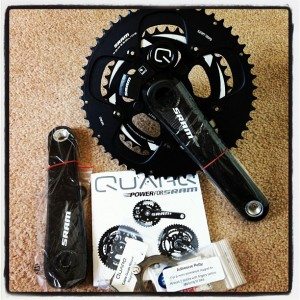
With the release of the 2012 Sram Red Quarq, prices for the previous Quarq Cinqo Saturn have been dropping precipitously. That being the case, now is the perfect time to grab them before they disappear from the market and used becomes your only option.
Since mid-season rest weeks are always prime tinkering time for me, what better time to change things up and swap out my Powertap in favor of one of the aforementioned Cinqo Saturns? After scoring a brandy new 130mm bcd Cinqo and having it arrive safely at my door (thank you UPS for not throwing it from 15 feet away) it was time to get my hands dirty and swap cranksets.
Unpacking
Opening the box (which is deceptively labeled as just “SRAM”) revealed the power meter assembled on the drive side crank arm along with Red Black 53/39 rings and a non-drive side crank arm. Digging deeper revealed pedal spindle washers, several sets of instructions, a calibration verification tag from the factory and several different cadence magnets. Weight on my scale was 781 grams for the Cinqo with both crank arms, chainrings and cadence magnet. This compared to 651 grams for my current (early model) Red standard crankset. 130 grams difference is about 1/4 of a pound, but it is at the most appropriate place: low on the bike and non-rotating mass.
The cranks appear to be quite sturdy and should handle anything most riders can dish out. They appear very similar to the old Truvativ Elita (which I still have on my cyclocross bike) and if so, they should last a long time. In this case no bottom bracket was included but I was able to simply re-use the GXP bottom bracket that I had been using with my Red setup.
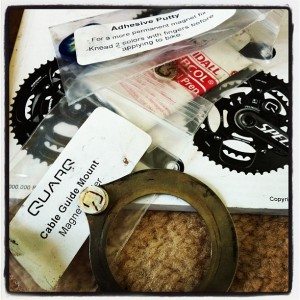 It's worth mentioning the variety of magnet options available with the Cinqo. I was also pleased to see that every option was included so the end user could choose which solution works best for them.
It's worth mentioning the variety of magnet options available with the Cinqo. I was also pleased to see that every option was included so the end user could choose which solution works best for them.
There is an included bottom bracket mount magnet, which has the magnet mounted to a very thin piece of ring shaped steel. It is designed to be used with threaded bottom brackets, being placed behind the bottom bracket as it is screwed into the shell. The next option is a cable guide mount magnet; a forked flat piece of steel with a magnet attached that slides under the cable guide mounted under the bottom bracket. Finally, for those with no other option, a direct mount magnet with epoxy putty is provided.
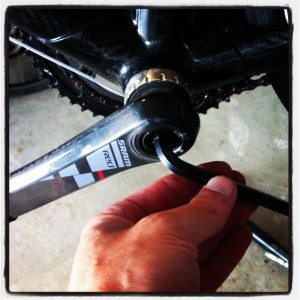
Installation
Installation really is a simple affair. It only really took an 8mm allen key, torque wrench and BB tool to get things installed.
Removing the Red crank was the first order of business, and in this case I was very thankful that I had used plenty of grease on the spindle threads before installing it. A couple taps with a rubber mallet dislodged the crank from the BB and it was easily removed from the frame.
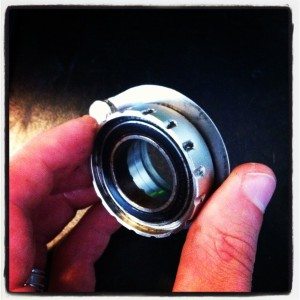 Next came removal of the drive side BB cup, easily accomplished with a Shimano BB tool. This step was necessary because I chose to utilize the BB ring mount cadence magnet instead of the cable guide or glue on magnet. The only consideration is that when reinstalling the BB cup, the magnet needs to be located at the 9 o'clock position in order to function properly. Unfortunately the ring has a tendency to spin a little when snugging down the BB cup, so care needs to be taken to line it up properly. It's worth taking the time to clean and grease the BB cup threads as well as the threads in the BB shell while you're at it.
Next came removal of the drive side BB cup, easily accomplished with a Shimano BB tool. This step was necessary because I chose to utilize the BB ring mount cadence magnet instead of the cable guide or glue on magnet. The only consideration is that when reinstalling the BB cup, the magnet needs to be located at the 9 o'clock position in order to function properly. Unfortunately the ring has a tendency to spin a little when snugging down the BB cup, so care needs to be taken to line it up properly. It's worth taking the time to clean and grease the BB cup threads as well as the threads in the BB shell while you're at it.
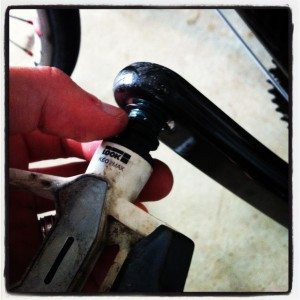 Installing the crank into the frame is as easy as sliding it into the BB. Grease the spindle threads, line up the non-drive side arm and torque it down to the specs listed in the manual.
Installing the crank into the frame is as easy as sliding it into the BB. Grease the spindle threads, line up the non-drive side arm and torque it down to the specs listed in the manual.
When re-installing the pedals, be sure to utilize the pedal spindle washers that are provided: the manual specifically recommends this. I'm not entirely sure why (whether it has an effect on the power readings or not, I'm not sure) but in this one rare instance, I'm going to follow directions. Surprising, right?
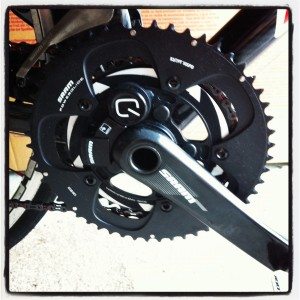 All that remains at this point is to check the shifting and make any small adjustments as necessary. In this case, the dimensions of the S975 crankset and the Red crankset are nearly the same, so there was very little tweaking necessary to make things function well. This is especially true considering the chainring size and brand are exactly the same as the crankset it's replacing. In some cases, minor front derailleur tuning may be necessary.
All that remains at this point is to check the shifting and make any small adjustments as necessary. In this case, the dimensions of the S975 crankset and the Red crankset are nearly the same, so there was very little tweaking necessary to make things function well. This is especially true considering the chainring size and brand are exactly the same as the crankset it's replacing. In some cases, minor front derailleur tuning may be necessary.
All things considered, installation is a very simple affair. Next time, we'll discuss pairing, zeroing and some of the pitfalls therein.